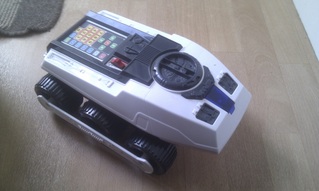| This is just a quick entry to outline the latest development with the AI-Duino project. Having installed the ultrasonic sensor, I wrote a very messy sketch to make it obstacle avoiding. As I did not have a spare stepper motor and driver I chose to mount the ultrasonic sensor in a fixed position. Due to this, I made the AI-Duino turn completely to assess the space to its left and right (once it had encountered an obstacle). I have included the sketch for anyone who would like to use it. All comments, feedback and suggestions are welcomed. | obstacle avoiding robot sketchN.B. This sketch utilises the ultrasonic sensor library discussed here. Also, please ignore my messy and unhelpful comments within the sketch. #include <Ultrasonic.h> /*-----( Import needed libraries )-----*/ #include "Ultrasonic.h" /*-----( Declare Constants and Pin Numbers )-----*/ #define TRIG_PIN 12 #define ECHO_PIN 13 /*-----( Declare objects )-----*/ Ultrasonic OurModule(TRIG_PIN, ECHO_PIN); /*-----( Declare Variables )-----*/ void setup() /****** SETUP: RUNS ONCE ******/ { Serial.begin(9600); Serial.println("UltraSonic Distance Measurement"); Serial.println("YourDuino.com [email protected]"); // initialize the digital pin as an output. // Pin 13 has an LED connected on most Arduino boards: pinMode(5, OUTPUT); pinMode(6, OUTPUT); pinMode(10, OUTPUT); pinMode(11, OUTPUT); } void loop() /****** LOOP: RUNS CONSTANTLY ******/ { Serial.print(OurModule.Ranging(CM)); Serial.print("cm "); delay(100); //Let echos from room dissipate Serial.print(OurModule.Ranging(INC)); Serial.println("inches"); int right = 0; int left = 0; delay(500); if((OurModule.Ranging(CM)) > 30) //if clear { Serial.print ("More than 30 CM"); Serial.print (" - Clear to Drive Forward"); digitalWrite(10, HIGH); // set the LED on ... forward digitalWrite(6, HIGH); // set the LED on ... forward //delay(1000); // wait for a second //digitalWrite(10, LOW); // set the LED off //digitalWrite(6, LOW); // set the LED off //delay(10); // wait for a second Serial.println (" - Drove Forward 1000"); delay(100); } if((OurModule.Ranging(CM)) < 30) //if obstical is in the way { Serial.print ("Less than 30 CM"); Serial.print (" - Obstical Detected"); Serial.print (" - Searching Surroundings"); digitalWrite(10, LOW); // set the motors off digitalWrite(6, LOW); // set the motors off digitalWrite(6, HIGH); // set the LED on ... turn left digitalWrite(11, HIGH); // set the LED on ... turn left delay(600); // wait for 6/10 second digitalWrite(6, LOW); // set the LED off digitalWrite(11, LOW); // set the LED off delay(100); // wait for a second Serial.print (" - Turned Left 90 Degrees "); left = (OurModule.Ranging(CM)); //take distance reading - left Serial.print(left); //digitalWrite(6, LOW); //digitalWrite(11, LOW); digitalWrite(5, HIGH); //turn right 180 degrees digitalWrite(10, HIGH); delay(1200); digitalWrite(5, LOW); // stop digitalWrite(10, LOW); Serial.print (" - Turned Right 180 Degrees "); right = (OurModule.Ranging(CM)); //take distance reading - right Serial.println(right); digitalWrite(6, HIGH); // return to centre digitalWrite(11, HIGH); delay(600); // wait for 6/10 second digitalWrite(6, LOW); //stop digitalWrite(11, LOW); delay(10); int dif = (left + 1000) - right; //working out if left or right has more space - less than 1000 means right has more room Serial.println (dif); if(dif>1000) // more room on the left { digitalWrite(6, HIGH); //turn left digitalWrite(11, HIGH); delay(600); //180 degrees digitalWrite(6, LOW); //stop digitalWrite(11, LOW); Serial.println(" turning 90 left - more space left"); } if(dif<1000) // more room on the right { digitalWrite(5, HIGH); //turn right digitalWrite(10, HIGH); delay(600); //180 degrees digitalWrite(5, LOW); //stop digitalWrite(10, LOW); Serial.println(" turning 90 left - more space right"); } } //} //void loop() { } |

 RSS Feed
RSS Feed
